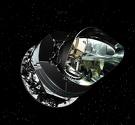ESA gearing up for launch two deep space telescopes – Herschel and Planck
 The European Space Agency (ESA) is gearing up for the launch of two deep space telescopes – Herschel and Planck – to dig into the history of cosmos and to trace the origins of stars and galaxies. The ESA is readying to blast off Herschel and Planck into space on the European Ariane-5 rocket on May 14, from its official spaceport at Guiana Space Centre at Kourou, French Guiana.
The European Space Agency (ESA) is gearing up for the launch of two deep space telescopes – Herschel and Planck – to dig into the history of cosmos and to trace the origins of stars and galaxies. The ESA is readying to blast off Herschel and Planck into space on the European Ariane-5 rocket on May 14, from its official spaceport at Guiana Space Centre at Kourou, French Guiana.
The ESA astronomers are currently running final checks on the project, in which thousands of scientists are involved, with British astronomers at forefront. The astronomers are claiming that the project will morphs our present understanding about the origin of the Universe and the birth stars and galaxies. The mission will answer some of the most important question in the space science, including how the universe was born, and how stars and galaxies were born.
Prof. David Southwood, the Mission chief, said, "This is going to change our view of the universe and where we have all come from – we are talking about the origin of galaxies and stars and even life itself."
The 7.5m Herschel space observatory probe is named after William Herschel, the astronomer who discovered Uranus. The Herschel, equipped with a mirror of 3.5m (11ft) in diameter, is going to be the largest telescope satellite ever put into space (the Hubble space telescope is equipped with mirror of 2.5m in diameter). The Herschel telescope – will probe into infrared radiation emitted by galaxies, stars, planets and comets – will study dust emitted by dying stars – will look life supporting elements in the Universe – will study the composition of comets and planets in our solar system.
Planck satellite is named after Max Planck, the German physicist, considered as the father of quantum mechanics. Planck will focus on the period immediately after the Big Bang. It will study “the minute fluctuations in the background 'echo' left over from the Big Bang - called Cosmic Microwave Background – to capture the finest details about the origin of the universe”.
“Herschel is going to look at the early stage of star growth and galaxy formation. Planck will allow us to travel back right to the beginning of time, 14 billion years ago,” said Professor Richard Holdaway from the UK Science and Technology Facilities Council, which has injected £30 million into the project.
According to the ESA, Herschel and Planck space observatories have already been fueled with hydrazine. The three-stage active cryogenic cooler of Planck, required to keep the instruments at extremely cold temperatures, has been filled with helium-3 and helium-4, and the cryogenic tanks of Herschel have also been filled with superfluid helium. Herschel will get detached from the rocket half an hour after the launch, while Planck will get separated a couple of minutes after Herschel. The total cost of the mission is estimated at €1.9 billion (£1.7 billion).